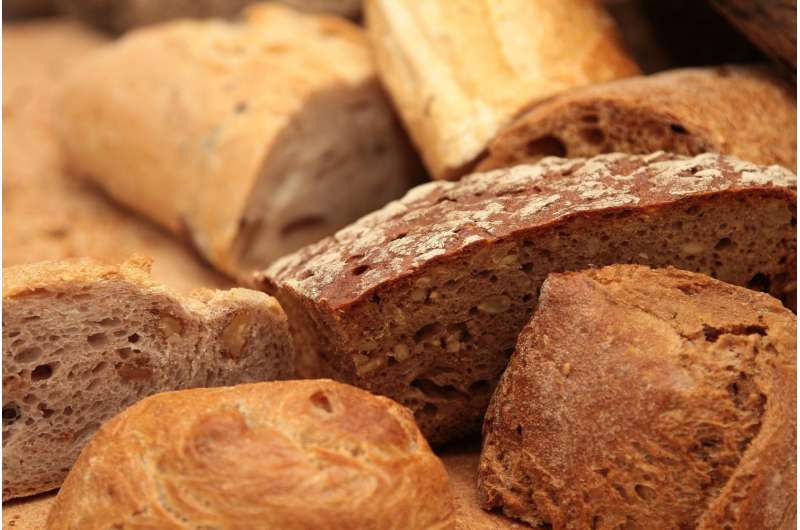Credit: CC0 Public Domain
Bread features heavily in many diets worldwide, and is one of the biggest sources of salt in diets. A new survey by World Action on Salt and Health (WASH), based at Queen Mary University of London, has revealed the shocking levels of salt present in this essential staple. WASH surveyed over 2,000 white, wholemeal, mixed grain and flat breads from 32 countries and regions, including over 500 products from Canada collected by Professor Mary L'Abbe's lab at the University of Toronto.
Researchers found that the saltiest bread in the survey—Rosemary Foccacia by ACE Bakery, available in Canada—had a shocking 2.65g of salt (1060mg sodium) per 100g, which is saltier than seawater. In fact, 73% of Canadian breads exceeded Health Canada's 2016 targets for sodium in bread products and 21% were above recommended maximum levels.
In Canadians more than 1 year of age, bread contributes the most sodium to dietary intakes (14%), primarily because it is consumed in large quantities. While voluntary sodium reduction benchmark targets exist in Canada, there is currently no federal or provincial sodium-monitoring program to track the food industry's progress, although aggregate data was published by Health Canada earlier this year.
Previous research by Professor L'Abbe's lab has examined industry's progress between 2010 and 2013 and found only a 6.6% reduction in bread products. Reducing salt in bread is an easy and effective way of lowering salt intake across the whole population—research has shown that the salt content of bread could be lowered by 25% over 6 weeks and consumers would not notice the difference.
More than 40% (44%) of white breads included in the WASH survey had more salt than the UK's maximum salt target. The Republic of Macedonia produced white breads with the highest salt content, averaging 1.42g/100g, compared to China which had the lowest average salt content of 0.65g/100g. Canadian breads in this category had an average salt content of 1.23g/100g, ranging from 0.43g/100g to 2.65g/100g.
Despite the UK's progress with salt reduction to date5, the average salt content of wholemeal breads from Qatar, China, Costa Rica and South Africa (0.78g/100g—0.92g/100g) were lower than the average salt content of wholemeal breads in the UK (0.93g/100g). This suggests that mandatory salt reduction targets, such as those put in place in South Africa, may be more effective than voluntary targets.
Although mixed grain breads had the lowest salt content of the bread categories, there was still a huge variation within this category. The highest salt bread available in Bulgaria had a salt content of 2.50g/100g, compared to the lowest salt bread available in Costa Rica with a salt content of 0.09g/100g, a massive 27-fold difference in salt content. In Canada the highest salt bread in this category had a salt content of 1.69 g/100g and the lowest 0.46 g/100g.
A recent survey by WASH11 found that a third of respondents felt that the WHO could do more to encourage countries to lower salt intakes. However, the majority of respondents felt that their country's government should take primary responsibility.
Professor Mary L'Abbe at the University of Toronto says: "Although recent Health Canada data has documented some progress in the reduction of sodium in prepackaged foods, Canadian bread products surveyed here demonstrate that more work is needed to meet recommended levels"
Mhairi Brown, Nutritionist at WASH, says: "This survey clearly demonstrates the progress still to be made to lower salt intake by 30% by 2025, in line with WHO recommendations. Bread is an essential staple food in many countries but is still a key source of salt in our diets due to the frequency with which we eat bread. Globally we must do more to reduce salt intake, and a simple way to do this is to lower salt in our staple foods."
Graham MacGregor, Professor of Cardiology at Queen Mary, University of London, and WASH Chairman says: "Eating too much salt puts up our blood pressure, the major cause of strokes, heart attacks and heart failure, the leading cause of death and disability worldwide. Reducing salt intake around the world would save millions of lives each year and all countries should be working towards reducing salt intake by 30% by 2025. Our survey has shown that many bread manufacturers internationally are still adding huge and unnecessary amounts of salt to their products. Governments must act now and reinvigorate salt reduction work in the food industry."
Provided by University of Toronto























